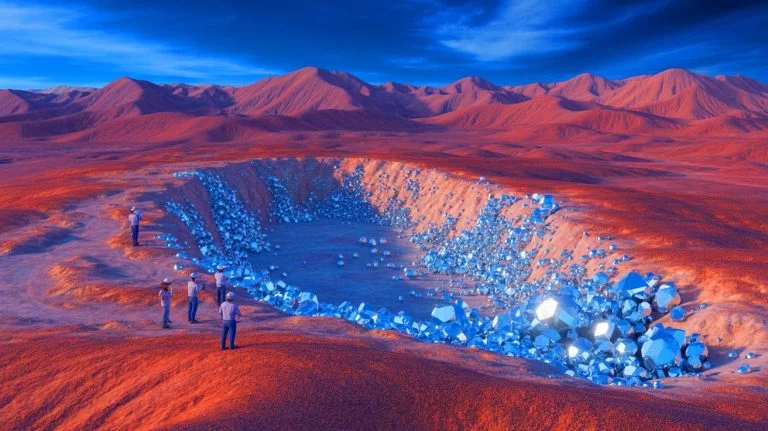| IN A NUTSHELL |
|
In a significant geological discovery, China has unearthed a massive zirconium reserve in the northern part of the Tarim Basin, Xinjiang province. This finding could have profound implications for global technology advancements and geopolitical dynamics. Zirconium, extracted from the mineral zircon, plays a crucial role in hypersonic and nuclear technologies. While the metal is abundant, its extraction is challenging, making it a high-demand commodity. China’s new reserve, reportedly four times larger than its previous holdings, could alter the landscape of international competition in advanced technologies. The discovery also challenges prior assumptions about zirconium’s geographical availability, suggesting untapped potential on land-based deposits.
The Challenges of Zirconium Extraction
Zirconium, despite being the 18th most abundant element in the Earth’s crust, presents significant extraction challenges. It does not occur as a native metal but is found chemically combined with other elements, primarily in the mineral zircon. Zircon is typically located in beach sands, riverbeds, and sedimentary deposits, which complicates its extraction process. Baddeleyite and other minerals also serve as less common sources of zirconium, adding to the complexity of its acquisition.
Globally, zirconium is primarily extracted from coastal sands, with China, Australia, Indonesia, South Africa, and Ukraine being major producers. The refining and processing of zircon to obtain zirconium are resource-intensive, making the acquisition of the metal costly. This factor underscores the strategic importance of China’s newfound reserve, potentially easing the burden of extraction and reducing costs.
Zirconium’s indispensable role in nuclear energy production, particularly as a cladding for fuel rods in reactors, further elevates its significance. Its high resistance to corrosion and heat, along with minimal neutron absorption properties, make it ideal for nuclear applications. Moreover, zirconium compounds are vital in aerospace for jet engines and space shuttle components due to their durability under extreme conditions.
Implications of China’s Zirconium Discovery
The discovery of a new zirconium reserve in the Tarim Basin is poised to significantly impact China’s standing in the global hypersonic and missile technology race. The reserve is estimated to be four times larger than China’s existing zirconium holdings, providing a substantial boost to its technological capabilities. As the United States and Russia intensify their efforts in developing hypersonic drones and missiles, China’s access to this strategic resource could enhance its competitive edge.
Historically, vast quantities of zirconium were believed to be confined to coastal regions, but this finding challenges that notion. The reserve, formed by ancient river and lake systems that transported zircon over long distances, offers new insights into the geological processes that concentrate zirconium in sedimentary layers. This opens up possibilities for exploring similar land-based deposits globally, potentially expanding the availability of this critical metal.
The reported average grade of the deposit exceeds 0.2 percent zircon, and it can be extracted through less energy-intensive processes, making it a highly attractive resource. This aspect not only reduces extraction costs but also aligns with global efforts to minimize environmental impacts associated with mining activities.
Strategic and Economic Considerations
China’s newfound zirconium reserve presents both strategic and economic opportunities. As a major player in the global technology supply chain, China’s control over a significant zirconium reserve could influence international markets and supply dynamics. The reserve’s potential to enhance China’s technological advancements in hypersonic and nuclear technologies underscores its strategic value.
From an economic perspective, the discovery could lead to reduced zirconium prices if extraction processes become more efficient and less costly. This would benefit industries reliant on zirconium, such as aerospace and nuclear energy, by lowering production costs. However, it could also create dependencies on Chinese supply chains, raising concerns about the concentration of critical resources in a single country.
Moreover, the discovery may prompt other nations to reassess their geological exploration strategies, searching for similar deposits within their territories. This could lead to increased investments in geological research and mining technologies, potentially diversifying the global supply of zirconium and reducing reliance on any single nation.
Potential Impact on Global Geopolitics
The geopolitical ramifications of China’s zirconium discovery are significant. As zirconium is crucial for advanced technologies with military applications, the reserve enhances China’s strategic capabilities. This development could shift power dynamics, particularly in the Asia-Pacific region, where technological supremacy is a major factor in geopolitical influence.
The discovery may also influence international relations, as countries that rely on zirconium for their technological and military advancements may seek stronger ties with China to secure access to this resource. This could lead to new alliances and shifts in existing partnerships, as nations navigate the complexities of resource dependency and strategic interests.
Furthermore, the discovery could prompt discussions on resource management and the ethical implications of concentrated resource control. As global challenges such as climate change and technological advancement intensify, the equitable distribution and sustainable management of critical resources like zirconium will be crucial in maintaining international stability and cooperation.
China’s discovery of a massive zirconium reserve is a game-changer in the realm of advanced technologies and resource management. The implications are far-reaching, affecting economic, strategic, and geopolitical landscapes. As the world grapples with the significance of this discovery, the question remains: How will global powers navigate the complexities of resource control and technological advancement in the coming years?
Did you like it? 4.3/5 (30)






Wow, this zirconium find is massive! Does this mean China could dominate the hypersonic race? 🤔
I wonder how this discovery will affect zirconium prices globally. Any chance they might go down?
Isn’t zirconium also used in jewelry? This could have a ripple effect in various industries!
What does this mean for the U.S. and its military tech? Should the Pentagon be worried? 😬
Another strategic win for China. It seems the balance of power might shift again. Interesting times ahead.
Thank you for the insightful article! I had no idea zirconium was so crucial for hypersonic tech.
Is this really a game-changer, or just another overhyped discovery? 🤨
China always seems to be a step ahead in tech advancements. What’s the secret sauce? 🇨🇳